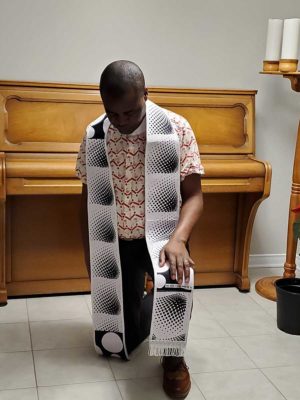
February is Black History Month — a time to commemorate, celebrate and recognize the achievements of Black Canadians. It is also an opportunity for people to learn more about the effects of racism and how to challenge negative stereotypes. It offers an opportunity for students, parents and educators to explore the rich history and identity of Black people.
With that in mind, the St. Stephen’s Black History Committee decided that the ideal way for parishioners to learn about and explore the rich history and identity of people of African descent would be by inviting people of African descent to share their life stories during a Sunday service. The committee developed a theme of “Lived Experiences.”
The first service was held on Feb. 7 with approximately 120 people in attendance online. The rector, the Rev. George Kwari, began the service by taking a knee in order to have the congregation pause and reflect on the significance of this gesture, particularly when taken by a Black man. The readings and musical selections reflected the Black struggle, faith and hope.
Denise Moore-Isaacs, a member of St. Stephen’s congregation, was the guest preacher and gave her account of lived experiences as a person of the Black community. She spoke about her life growing up in Toronto where her brother was stopped on his way to a hockey practice. The police officer who stopped him did not think a black boy would be playing hockey. She noted that most systems were built without people of colour in mind and how disadvantaged they are at times. Most people of African descent tend to conduct themselves in a certain way in order to fit into a traditional system that was not build with them in mind. She shared the story of her 83-year-old father who experienced racism and discrimination at work and in everyday activities throughout his life and how his story intersects with experiences of generational discrimination. To this day he is seeking justice. She talked about examples of incidents of racial discrimination that have affected us: George Floyd, Abdirahman Abdi, Joyce Echequan, Mr. Camara and posed the question, “How do we explain these incidents to our children?” In closing, she exhorted everyone to ‘listen to understand’; challenged them to review their mindsets, behaviour and biases, including those that may be subconscious.
As you can imagine, this was a wonderful starting point for an after-service conversation. About 50 people stayed for an enlightening, honest and informative conversation. People shared their stories, including accounts of visiting the Martin Luther King Jr. memorial and of sitting in the seat which had been occupied by Rosa Parks. Participants were reminded of the existence of the Underground Railroad and Niagara’s Freedom Trail in St. Catharines, Ont., the city where Harriet Tubman and Josiah Henson made their homes.
A priest added that, in his previous white-dominated community where he was the only black person, people just called him by colour and didn’t make an effort to learn his name. To which one of the parishioners quickly jumped in and said, “If I were the only white person in a black community, I would not want them to call me, ‘hey white woman.’” People of colour would appreciate others learning their names and not to referring to them as the black priest or black warden.
One parishioner, speaking offline because she didn’t feel comfortable speaking out, said the world would move forward if we stop using the word ‘black.’ She had never seen a black person. This person did not speak because she never felt qualified to speak in front of white people. However, it must be noted that the issue of colour label was echoed in other comments from some of the participants. Some thought that the media is both a friend and enemy in the fight against racism.
We discussed the idea that if people’s colour is mentioned not in a derogatory way but in an affectionate way, it is far more acceptable. Acknowledging that a person is Black means that you are acknowledging who they are and the ordeal people of colour go through. It was interesting to note that children do not often notice the colour of people’s skin, which might be due to the fact that it does not bother them.
The parishioners shared a list of books and other materials they had read. It was agreed that the Black History Committee would create a list of books that members of St Stephen’s can read throughout the year, thereby fulfilling the Committee’s request that we learn about Black history all year round.
We had a fulsome and honest conversation. As we saw, everyone has a unique story. If we do not take the opportunity to listen to these stories, we are going to miss out on the full picture of who we are today. We need each person’s story in order to build the bigger picture. People must be allowed to talk freely about the ‘elephant in the room’—colourism and racism in the Church.
It takes a village to fight against racism. Thank you, people of St. Stephen’s, a church without walls, as it is affectionately known for its space, and for your whole-hearted participation. Let us march on!
— Dr. Shirley Brathwaite, the Rev. George Kwari and Denise Moore-Isaacs.



An abiding sense of thanksgiving